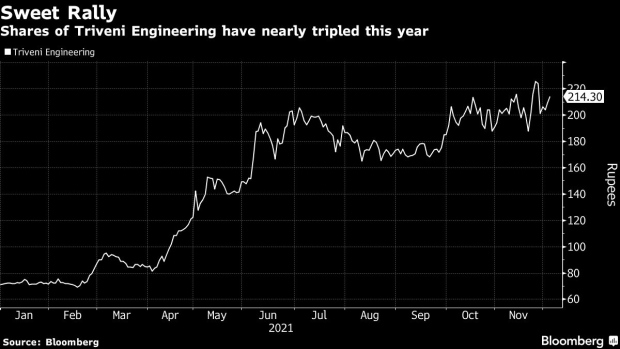Dec 7, 2021
Sugar Mill With 200% Stock Rally Looks to Ride Modi’s Green Push
, Bloomberg News

(Bloomberg) -- Triveni Engineering & Industries Ltd., whose shares have surged 200% this year, plans to double its biofuel production capacity to take advantage of the government’s ambitious ethanol blending program.
India’s second-biggest sugar producer will begin operations at a new plant to make ethanol from cane juice, molasses and damaged grains from February, Managing Director Tarun Sawhney said in an interview. The company, which is spending about 3.5 billion rupees ($46 million) on its expansion plans, operates seven sugar mills, besides running other business such as power transmission and water project management.
“There has been a forceful agenda that we have to march toward the goal of 20% ethanol blending,” Sawhney said. The target of Prime Minister Narendra Modi’s government to mix gasoline with one-fifth of ethanol by 2025 is no “rhetoric” as many mills have planned to expand their capacities, he said, adding that states like Bihar and Odisha are offering additional incentives.
The government this year advanced its biofuel blending target to 2025, five years earlier than planned, to cut air pollution, trim oil import bills, help soak up a local sugar glut and boost investment in rural areas. The world’s third-biggest oil importer plans to spend about $7 billion on the program, which envisages tripling the nation’s ethanol output to about 10 billion liters a year.
The company’s renewed focus on biofuels could further support its blistering share price rally, which has been drawing support from the government’s reforms. The company’s move indicates that a pick up in the pace of the country’s ethanol output could help it cut a sugar surplus of about 8 million tons and eliminate the need to subsidize exports.
With the start of the factory at Milak Narayanpur in Uttar Pradesh, India’s top sugar-producing state, and the completion of some other projects, Triveni Engineering’s distillery capacity will climb to 660 kiloliters a day by June from about 320 kiloliters now, Sawhney said.
Export Parity
Indian mills are expected to divert cane juice and molasses equivalent to about 3.4 million tons of sugar to make ethanol during the year that started in October, according to the Indian Sugar Mills Association. The world’s second-biggest producer is estimated to produce 30.5 million tons of sugar this year.
Triveni, which estimates its output to stay flat at about 938,000 tons in 2021-22, has not booked any export contract so far during the current season due to unfavorable global prices and higher cane prices in Uttar Pradesh, Sawhney said.
“We have not seen the parity” yet as state-administered prices of sugar cane have also gone up in Uttar Pradesh, he said. However, an expected global supply crunch in the first quarter of the next year would put India in a “fortuitous position” to make up for it, he said. “If we see some spikes in international prices, we’ll have more contracts.”
The ISMA said last week that the nation had stopped signing new export contracts as a sharp decline in global prices had made shipments unviable. The setback came at a time when the pace of new deals was gathering momentum. Indian exporters have so far inked deals to export 3.5 million tons during the current season.
©2021 Bloomberg L.P.


